The Multicultural Mystique: The Liberal Case Against Diversity
by Harriet E. Baber
Prometheus Books, 246 pages, $27.
This book caught my eye because it contains some of the most insightful and honest critique of multiculturalism I have ever read. On the other hand, its “solution” is to remove culture from the picture entirely, which is so brain-dead I have trouble respecting the book.
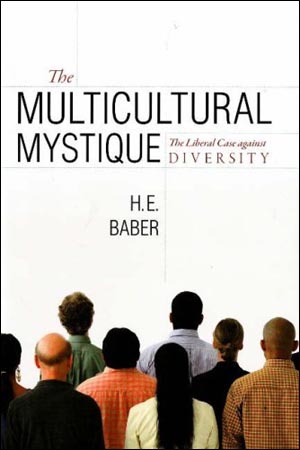 Onward to the good, however: this book gives us a working definition of each type of multiculturalism, albeit with hokey postmodern-style metaphors. The kind the author rails against is “salad bowl” multiculturalism, where members of different ethnic groups move to a new land and then stay segregated by ethnicity. The kind the author endorses is assimilation, or everyone giving up on their source culture and joining the new culture. Difficulty: the author admits that such a culture doesn’t exist, and just about goes far enough to admit that diversity kills it, but then launches on a praiseful tirade in favor of individualism and having no higher cultural goals.
Onward to the good, however: this book gives us a working definition of each type of multiculturalism, albeit with hokey postmodern-style metaphors. The kind the author rails against is “salad bowl” multiculturalism, where members of different ethnic groups move to a new land and then stay segregated by ethnicity. The kind the author endorses is assimilation, or everyone giving up on their source culture and joining the new culture. Difficulty: the author admits that such a culture doesn’t exist, and just about goes far enough to admit that diversity kills it, but then launches on a praiseful tirade in favor of individualism and having no higher cultural goals.
The justification used for this course of action comes right out of the early 1990s. Baber distinguishes between “salient,” or components of our social identity, and non-salient attributes to individuals, like ethnicity. No attempt is made to address populations as organic wholes; in fact, that heresy against deconstruction is considered outside the realm of intelligent discourse. Her point is that majority cultures like indigenous whites in Europe and America do not have to notice their race (you can find this sentiment in any publication on “white privilege”) but that anyone else must.
For white Americans, ethnic identification is largely a matter of choice, since whiteness in the United States and Europe is nonsalient and, as it were, transparent. This is, indeed, the fundamental characteristic of “white privilege”: to be white is, in an important sense, to lack racial identity, to be “just regular” as regards race. (10)
At this point, her liberal thinking takes a turn toward the semi-Randian. Having expectations of culture imposed upon you, she says, limits your ability to be individualistic and to make individualistic choices because your ethnic group will enforce them upon you and if they don’t, society at large will project them on you. She uses delightful examples like overachieving black kids getting dinged for “acting white,” or clueless white people politely asking random black people to explain Kwanzaa.
However, ultimately her solution is a dumbed-down modern form of colonialism: import the people to your country, integrate them into your culture, and in a few generations they will have lost whatever origins they had. It is colonial because as she frequency points out, non-majority-ish populations get imported as cheap labor, with the hope and guess that they will depart when the wages go:
The worry that mass immigration will make receiving countries “too diverse” or that it will “thin out” their cultures is a sham. The fear is that immigrants will not remain sufficiently “diverse” to accept second-class jobs, do harsh jobs for low pay, and conveniently disappear when their labor is not needed. (233)
This passage shows the book in microcosm: insightful analysis that reveals the attitudes of Americans toward their imported diverse labor pool, coupled with editorializing that considers a few out of the many factors and plays fast and loose with the concept of ethnicity in contrast to culture.
Profundity and the same old boilerplate wrapped together in an easy package? It’s kind of like honor students who own that one Iron Maiden album so they can, you know, let loose and walk on the wild side every tenth Saturday night. If you write for the liberal establishment, you have to smother any dose of shock with a heaping helping of familiar territory.
Another example:
The relevant moral questions are: to what extent does the cultural self-affirmation of some members of a group have consequences for other members of the group and are those consequences so significant as to override rights to free speech, religious freedom, and self-expression? These rights are not absolute. (165)
Baber hones in on the central issue of modern time, which is whether our individualism is absolute, and comes down in favor of the absolute — without presenting an argument for it. Assumptions exist, and personal histories, but we’re not seeing a cause-effect reason for these assumptions. However, the question needed to be asked, and it’s better in print from a liberal source than from a conservative one which would immediately be dismissed by anyone left of center.
In this chapter, I also address the important question, rarely discussed, of when, if ever, ethnic diversity ends. Do multiculturalists imagine that the salad bowl is forever and that ethnic minorities will maintain distinct cultural identities in perpetuity without coalescing? It is hard to see how such an arrangement could be maintained without the establishment of a virtual millet system of semiautonomous communities maintaining their own schools, institutions, and, perhaps, systems of personal law with the approval and support of the state. (11)
These are very important questions. Baber does not ask what happens when the “majority” population the United States and Europe is in fact worldwide a minority population, and a wealthy one, which means that many more of them want to move here than there are members of the “majority” group. Do they get bred out? Do they have a right to exist as well? You won’t find that in this book.
The Multicultural Mystique may be fun because it is such a mixed bag. Baber brings up the important issues; she then explains them away with stock-in-trade liberal platitudes. Because the liberal modus operandi is to take an individualist position, and passive aggressively react to any assertion of a different viewpoint as if it were straight out of a hostile nation’s propaganda broadcast, she does what most political writers tend to do, which is cherry-pick sources. Why consider multiple factors, when there’s one you need? Why mention the breadth of an issue, when you can take data out of context and imply its relevance? A good deal of the arguments in this book conclude with her asserting an example that might support them, and as if that proof were evident, ending the paragraph.
In style, the book resembles much of the other popular literature from our philosophy departments. Its strength is that it makes its points clearly; its weakness is that it deconstructs so much that the entire document is not a strawman attack, but a strawman discussion, with theoretical beings existing in vacuums without time, place or context batting each other around using absolute concepts like individual rights. Much of it reeks of a lonely white woman alone in a Starbuck’s, writing from a stack of The Atlantic magazines and what she can find with Google, and not bothering to edit for circularity. Around we go again and again; fifty to a hundred pages could have dropped from this book with no loss in meaning.
For all of its faults and biases, however, The Multicultural Mystique won me over because it kicks open the door on several important issues: Assimilate or respect culture? We know this path will destroy culture and replace it with individual desire, right? No one is thinking past the immediate; most people who support diversity do so for low-cost lawn care and social identity points. And last but not least, what is the goal here? Do we want culture, or not, and if not, why? Many of these questions arise from the reading of the book and are not embedded in it, which makes it doubly impressive as a conversation starter.
Your average person will not find this book compelling because it is, without exception, and indulgently so, written in the “philosophical” style of lots of flavor-words for concepts, plenty of comma-separated phrases, with allusions to terms trending in academia. However, for those who are interested in this issue which since 1865 has dominated American and European politics, The Multicultural Mystique provides a good place to start your open-minded research by seeing what the best of the liberal side have to say.
You can find this book on Amazon for $27.




 del.icio.us
del.icio.us
 Digg
Digg



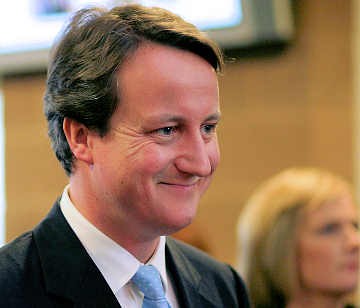
 Nous sommes dans une situation paradoxale qu’on a retrouvée lors des débats sur l’identité française ou de l’expulsion des Roms. Il y a une tension entre le citoyen et l’individu.
Nous sommes dans une situation paradoxale qu’on a retrouvée lors des débats sur l’identité française ou de l’expulsion des Roms. Il y a une tension entre le citoyen et l’individu.
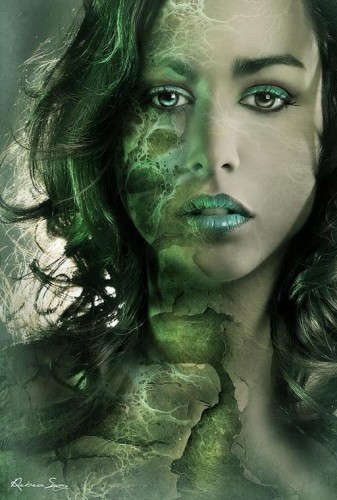 Le projet d'instauration d'une société multiculturelle où les cultures, les religions, entreraient en dialogue, s'enrichissant mutuellement de leur diversité, a paru de nature à remplacer avec bonheur l'ancienne recherche d'assimilation de ceux qui venaient d'ailleurs. Les Pays-Bas, la Grande-Bretagne et quelques autres ont été en pointe dans ce domaine. Et voilà que le vent tourne. Comment comprendre la montée d'un populisme xénophobe dans une bonne partie de l'Europe ? Réaction de populations déstabilisées par la crise économique mondiale et en quête d'un bouc émissaire ? Ou effet des limites d'une utopie ?
Le projet d'instauration d'une société multiculturelle où les cultures, les religions, entreraient en dialogue, s'enrichissant mutuellement de leur diversité, a paru de nature à remplacer avec bonheur l'ancienne recherche d'assimilation de ceux qui venaient d'ailleurs. Les Pays-Bas, la Grande-Bretagne et quelques autres ont été en pointe dans ce domaine. Et voilà que le vent tourne. Comment comprendre la montée d'un populisme xénophobe dans une bonne partie de l'Europe ? Réaction de populations déstabilisées par la crise économique mondiale et en quête d'un bouc émissaire ? Ou effet des limites d'une utopie ?

 Linkse activisten dragen de schuld voor de fouten in het huidige integratiebeleid: sinds lang hebben die ieder debat onmogelijk gemaakt. Maar bovenal was en is het doel van de multiculturele campagnes de vernietiging van het eigene, "tot de overgrote meerderheid weet wat van hen verwacht wordt en de rol speelt die hen is opgelegd."
Linkse activisten dragen de schuld voor de fouten in het huidige integratiebeleid: sinds lang hebben die ieder debat onmogelijk gemaakt. Maar bovenal was en is het doel van de multiculturele campagnes de vernietiging van het eigene, "tot de overgrote meerderheid weet wat van hen verwacht wordt en de rol speelt die hen is opgelegd." Ook in Nederland is het voorduren van de massa-immigratie zeer aannemelijk een opzettelijk project van de progressieve politiek die volgde op de ontrouw van de wegvluchtende kiezers waar vooral de PvdA eind zestiger mee te kampen had.[1] Volgens de Provo-beweging in die periode had de welvaartsmaatschappij het ontrouwe arbeiderselectoraat "in slaap gesust". De arbeiders waren ontaard tot een "grauwe, gemakzuchtige massa". Van dit "klootjesvolk" hoefde niemand mee iets positiefs te verwachten," schrijft Duco van Weerlee in Wat de provo’s willen.[2] Of in de taal van de Amsterdamse Provo’s:
Ook in Nederland is het voorduren van de massa-immigratie zeer aannemelijk een opzettelijk project van de progressieve politiek die volgde op de ontrouw van de wegvluchtende kiezers waar vooral de PvdA eind zestiger mee te kampen had.[1] Volgens de Provo-beweging in die periode had de welvaartsmaatschappij het ontrouwe arbeiderselectoraat "in slaap gesust". De arbeiders waren ontaard tot een "grauwe, gemakzuchtige massa". Van dit "klootjesvolk" hoefde niemand mee iets positiefs te verwachten," schrijft Duco van Weerlee in Wat de provo’s willen.[2] Of in de taal van de Amsterdamse Provo’s: Colombo haalt twee recente door moslimvrouwen geschreven boeken aan die het multiculturalisme definiëren als "een dwaling" en "een deceptie." Der Multikulti-Irrtum, Wie wir in Deutschland besser zusammen leben können ("De Multiculti-dwaling"), gepubliceerd in Duitsland in 2007, geschreven door
Colombo haalt twee recente door moslimvrouwen geschreven boeken aan die het multiculturalisme definiëren als "een dwaling" en "een deceptie." Der Multikulti-Irrtum, Wie wir in Deutschland besser zusammen leben können ("De Multiculti-dwaling"), gepubliceerd in Duitsland in 2007, geschreven door "Het beginsel van de politieke correctheid vergt een absoluut respect voor de cultuur van niet-westerse volkeren, wat multiculturalisme genoemd wordt. Maar wat als die niet-westerse culturen in hun gedrag geen respect voor vrouwen kennen? (…) Het multiculturalisme kent alleen maar slachtoffers. Slachtoffers als Hina Saleem uit Brescia, de Pakistaanse die door haar vader onthoofd werd en in de tuin begraven "omdat zij zich gedroeg als een christen"; als Bouchra, een Marokkaanse uit Verona, die doodgestoken werd door haar man omdat zij weigerde de sluier te dragen; als Fouzia, de Egyptische uit Milaan die door haar echtgenoot voor de ogen van haar driejarige dochtertje gewurgd werd en vervolgens in een park gedumpt, omdat zij zich westers kleedde; als Fatima Saamali, de Marokkaanse uit Aosta die door haar man werd vermoord omdat zij aan de politie had gerapporteerd dat zij door haar man mishandeld werd…"
"Het beginsel van de politieke correctheid vergt een absoluut respect voor de cultuur van niet-westerse volkeren, wat multiculturalisme genoemd wordt. Maar wat als die niet-westerse culturen in hun gedrag geen respect voor vrouwen kennen? (…) Het multiculturalisme kent alleen maar slachtoffers. Slachtoffers als Hina Saleem uit Brescia, de Pakistaanse die door haar vader onthoofd werd en in de tuin begraven "omdat zij zich gedroeg als een christen"; als Bouchra, een Marokkaanse uit Verona, die doodgestoken werd door haar man omdat zij weigerde de sluier te dragen; als Fouzia, de Egyptische uit Milaan die door haar echtgenoot voor de ogen van haar driejarige dochtertje gewurgd werd en vervolgens in een park gedumpt, omdat zij zich westers kleedde; als Fatima Saamali, de Marokkaanse uit Aosta die door haar man werd vermoord omdat zij aan de politie had gerapporteerd dat zij door haar man mishandeld werd…" Solzjenitsyn wijst op het onderwijs – op de manier waarop leerkrachten het als hun plicht zagen om een soort van vijandigheid in te prenten tegen iedere vorm van traditionele autoriteit – als de belangrijkste factor die verklaart waarom de jeugd van Rusland werd verleid voor socialistische revolutionaire ideeën. In het Westen gedurende de jaren '60 en '70 – die collectief "de jaren '60" genoemd kunnen worden – zien we een krachtige echo van de collectieve mentale capitulatie die in de jaren '70 van de negentiende eeuw in Rusland plaatsvond, en werd voortgezet in de revolutie (van 1917).
Solzjenitsyn wijst op het onderwijs – op de manier waarop leerkrachten het als hun plicht zagen om een soort van vijandigheid in te prenten tegen iedere vorm van traditionele autoriteit – als de belangrijkste factor die verklaart waarom de jeugd van Rusland werd verleid voor socialistische revolutionaire ideeën. In het Westen gedurende de jaren '60 en '70 – die collectief "de jaren '60" genoemd kunnen worden – zien we een krachtige echo van de collectieve mentale capitulatie die in de jaren '70 van de negentiende eeuw in Rusland plaatsvond, en werd voortgezet in de revolutie (van 1917). Eén van de echo's van het marxisme die vandaag de dag maar blijft nagalmen, is het idee dat waarheid in een klasse zit opgesloten (of geslacht of ras of erotische geaardheid). De waarheid is dan niet iets dat kan worden vastgesteld door rationeel onderzoek, maar is afhankelijk van het perspectief van de spreker. In het multiculturele universum is het perspectief van een persoon "getaxeerd" naar klasse. Feministen en allochtonen bijvoorbeeld hebben een grotere aanspraak op de waarheid, omdat ze "onderdrukt" zouden worden. In de ellende van die "onderdrukking" vinden zij de waarheid eerder dan bij de witte heteroseksuele mannen die hen "onderdrukken". Dit is een perfect spiegelbeeld van de morele en intellectuele superioriteit van het marxistische proletariaat ten opzichte van de bourgeoisie. Tegenwoordig verleent "onderdrukking" een "bevoorrecht perspectief" dat in wezen onfeilbaar is. Om een uitdrukking uit Robert Bork's Naar Gomorra te parafrasereren, zijn etnische minderheden en feministische activisten "gestaald tegen het logische argument" – net zoals de ware communistische gelovigen dat waren.
Eén van de echo's van het marxisme die vandaag de dag maar blijft nagalmen, is het idee dat waarheid in een klasse zit opgesloten (of geslacht of ras of erotische geaardheid). De waarheid is dan niet iets dat kan worden vastgesteld door rationeel onderzoek, maar is afhankelijk van het perspectief van de spreker. In het multiculturele universum is het perspectief van een persoon "getaxeerd" naar klasse. Feministen en allochtonen bijvoorbeeld hebben een grotere aanspraak op de waarheid, omdat ze "onderdrukt" zouden worden. In de ellende van die "onderdrukking" vinden zij de waarheid eerder dan bij de witte heteroseksuele mannen die hen "onderdrukken". Dit is een perfect spiegelbeeld van de morele en intellectuele superioriteit van het marxistische proletariaat ten opzichte van de bourgeoisie. Tegenwoordig verleent "onderdrukking" een "bevoorrecht perspectief" dat in wezen onfeilbaar is. Om een uitdrukking uit Robert Bork's Naar Gomorra te parafrasereren, zijn etnische minderheden en feministische activisten "gestaald tegen het logische argument" – net zoals de ware communistische gelovigen dat waren.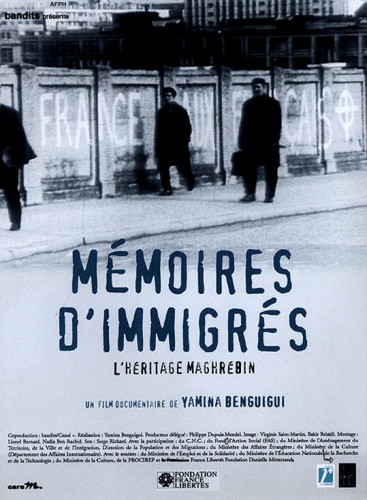 D’abord, on nous a parlé de “travailleurs immigrés” (gastarbeiders), puis d’étrangers (vreemdelingen), puis d’immigrés (immigranten) puis d’allochtones (allochtonen) puis de “nouveaux Belges” (nieuwe Belgen) et, enfin, de migrants (migranten). Tous ces termes ont acquis au fil du temps une connotation négative. Le parti “ChristenUnie’ (CU) aux Pays-Bas, a imaginé une nouvelle dénomination, qui, supposent ses adeptes, gommera cette connotation négative: on parlera désormais de “citoyens biculturels” (1). D’après la dame qui a inventé ce nouveau concept, une certaine Cynthia Ortega-Martijn, celui-ci aurait un “effet adoucissant” (“een verzachtende werking”).
D’abord, on nous a parlé de “travailleurs immigrés” (gastarbeiders), puis d’étrangers (vreemdelingen), puis d’immigrés (immigranten) puis d’allochtones (allochtonen) puis de “nouveaux Belges” (nieuwe Belgen) et, enfin, de migrants (migranten). Tous ces termes ont acquis au fil du temps une connotation négative. Le parti “ChristenUnie’ (CU) aux Pays-Bas, a imaginé une nouvelle dénomination, qui, supposent ses adeptes, gommera cette connotation négative: on parlera désormais de “citoyens biculturels” (1). D’après la dame qui a inventé ce nouveau concept, une certaine Cynthia Ortega-Martijn, celui-ci aurait un “effet adoucissant” (“een verzachtende werking”).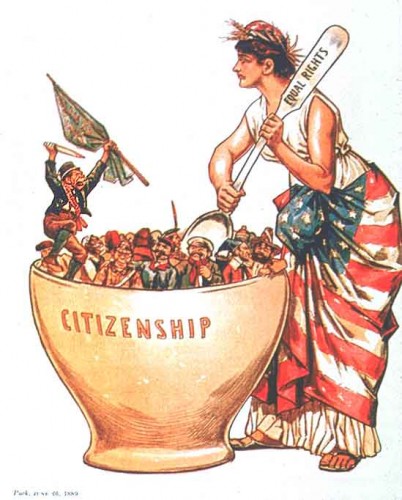 Louis Farrakhan n'est pas le seul Américain qui exprime aujourd'hui du scepticisme à l'égard de l'idéal d'intégration raciale. Tony Brown, Républicain noir et hôte de la chaîne de télévision PBS, condamne, lui aussi, cette tendance contemporaine à l'“assimilation raciale”. Voici son argument majeur: «Nous pouvons rester séparés racialement tout en maintenant une nation saine et productive». Clarence Thomas, de la Cour Suprême de Justice, a condamné les projets d'intégration scolaire fondés sur le principe que les non-Blancs doivent s'asseoir à côté des Blancs dans les école pour acquérir de l'éducation (!). Tant parmi les Noirs que parmi les Blancs, le projet d'intégration est respecté par conformisme et non plus par conviction réelle, comme l'indique du reste le fait patent que dans tous les domaines sociaux où l'intégration n'est pas imposée par coercition, les races choisissent toutes de vivre séparément. Dans les églises, les prisons, à l'armée, dans les équipes professionnelles d'athlétisme, sur les campus universitaires, les races suivent toutes leur propre voie. Nous avons donc affaire à une ségrégation que les gens, toutes races confondues, s'imposent spontanément à eux-mêmes: reste à savoir si cet état de choses est aussi choquant et aussi indésirable que les commentateurs médiatiques veulent nous le faire croire...
Louis Farrakhan n'est pas le seul Américain qui exprime aujourd'hui du scepticisme à l'égard de l'idéal d'intégration raciale. Tony Brown, Républicain noir et hôte de la chaîne de télévision PBS, condamne, lui aussi, cette tendance contemporaine à l'“assimilation raciale”. Voici son argument majeur: «Nous pouvons rester séparés racialement tout en maintenant une nation saine et productive». Clarence Thomas, de la Cour Suprême de Justice, a condamné les projets d'intégration scolaire fondés sur le principe que les non-Blancs doivent s'asseoir à côté des Blancs dans les école pour acquérir de l'éducation (!). Tant parmi les Noirs que parmi les Blancs, le projet d'intégration est respecté par conformisme et non plus par conviction réelle, comme l'indique du reste le fait patent que dans tous les domaines sociaux où l'intégration n'est pas imposée par coercition, les races choisissent toutes de vivre séparément. Dans les églises, les prisons, à l'armée, dans les équipes professionnelles d'athlétisme, sur les campus universitaires, les races suivent toutes leur propre voie. Nous avons donc affaire à une ségrégation que les gens, toutes races confondues, s'imposent spontanément à eux-mêmes: reste à savoir si cet état de choses est aussi choquant et aussi indésirable que les commentateurs médiatiques veulent nous le faire croire...
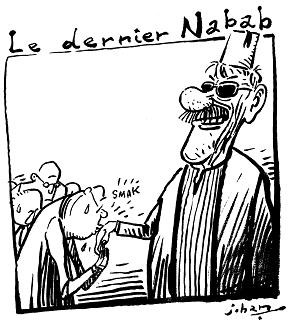 Men zou dus denken dat de voorstellen van politici voor een ééngemaakte politiezone Brussel, nu heeft elke burgemeester zowat zijn eigen politiemacht, en een zerotolerantie op algemene consensus wordt onthaald. Dit is wel en niet het geval. Langs Vlaamse kant zijn alle partijen het eens dat dit moet gebeuren, van Groen! t.e.m. het Vlaams Belang. Maar, afgaande ook op de berichtgeving in het avondjournaal op Één, is dit langs Franstalige kant zeker niet het geval. Daar worden de voorstellen tot hervorming bekeken als “Vlaamse eisen” en “extreem-rechtse” praat.
Men zou dus denken dat de voorstellen van politici voor een ééngemaakte politiezone Brussel, nu heeft elke burgemeester zowat zijn eigen politiemacht, en een zerotolerantie op algemene consensus wordt onthaald. Dit is wel en niet het geval. Langs Vlaamse kant zijn alle partijen het eens dat dit moet gebeuren, van Groen! t.e.m. het Vlaams Belang. Maar, afgaande ook op de berichtgeving in het avondjournaal op Één, is dit langs Franstalige kant zeker niet het geval. Daar worden de voorstellen tot hervorming bekeken als “Vlaamse eisen” en “extreem-rechtse” praat. Het gaat daar dus ondertussen zo ver dat men, puur uit koppigheid en oogkleppenmentaliteit, regelrecht weigert om maatregelen te nemen. Die ideeën komen immers uit Vlaamse hoek en het Vlaams Belang heeft die ideeën ook geuit. Dat is zoals verkiezen om te verdrinken omdat de persoon die je wilt komen redden een andere maatschappijvisie heeft. In Terzake van 1 februari 2010 konden we ook nog vernemen dat deze overvallen, volgens
Het gaat daar dus ondertussen zo ver dat men, puur uit koppigheid en oogkleppenmentaliteit, regelrecht weigert om maatregelen te nemen. Die ideeën komen immers uit Vlaamse hoek en het Vlaams Belang heeft die ideeën ook geuit. Dat is zoals verkiezen om te verdrinken omdat de persoon die je wilt komen redden een andere maatschappijvisie heeft. In Terzake van 1 februari 2010 konden we ook nog vernemen dat deze overvallen, volgens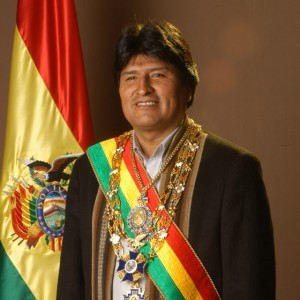
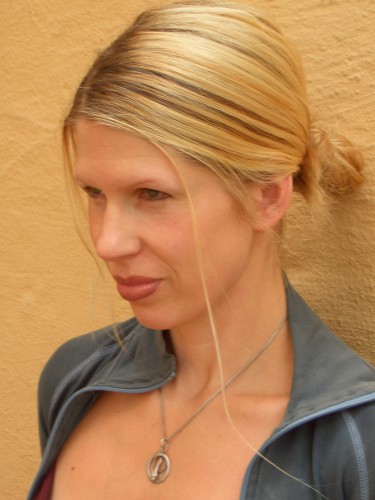 Ellen KOSITZA
Ellen KOSITZA
 Immigration et identité
Immigration et identité



 “La journée de la jupe” :
“La journée de la jupe” :